heater CHEVROLET HHR 2006 1.G Owners Manual
[x] Cancel search | Manufacturer: CHEVROLET, Model Year: 2006, Model line: HHR, Model: CHEVROLET HHR 2006 1.GPages: 394, PDF Size: 2.33 MB
Page 83 of 394
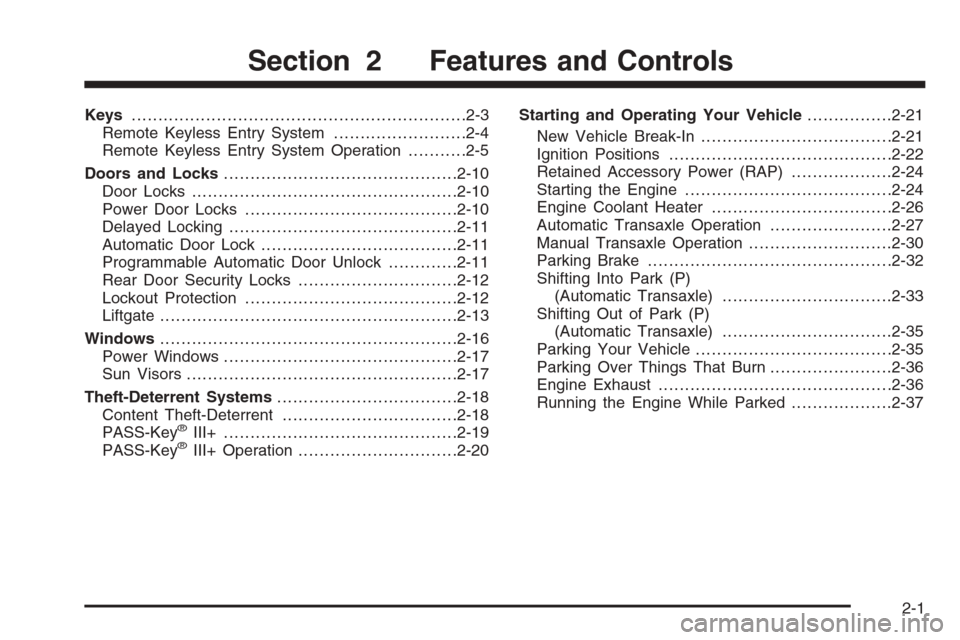
Keys...............................................................2-3
Remote Keyless Entry System.........................2-4
Remote Keyless Entry System Operation...........2-5
Doors and Locks............................................2-10
Door Locks..................................................2-10
Power Door Locks........................................2-10
Delayed Locking...........................................2-11
Automatic Door Lock.....................................2-11
Programmable Automatic Door Unlock.............2-11
Rear Door Security Locks..............................2-12
Lockout Protection........................................2-12
Liftgate........................................................2-13
Windows........................................................2-16
Power Windows............................................2-17
Sun Visors...................................................2-17
Theft-Deterrent Systems..................................2-18
Content Theft-Deterrent.................................2-18
PASS-Key
®III+............................................2-19
PASS-Key®III+ Operation..............................2-20Starting and Operating Your Vehicle................2-21
New Vehicle Break-In....................................2-21
Ignition Positions..........................................2-22
Retained Accessory Power (RAP)...................2-24
Starting the Engine.......................................2-24
Engine Coolant Heater..................................2-26
Automatic Transaxle Operation.......................2-27
Manual Transaxle Operation...........................2-30
Parking Brake..............................................2-32
Shifting Into Park (P)
(Automatic Transaxle)................................2-33
Shifting Out of Park (P)
(Automatic Transaxle)................................2-35
Parking Your Vehicle.....................................2-35
Parking Over Things That Burn.......................2-36
Engine Exhaust............................................2-36
Running the Engine While Parked...................2-37
Section 2 Features and Controls
2-1
Page 108 of 394
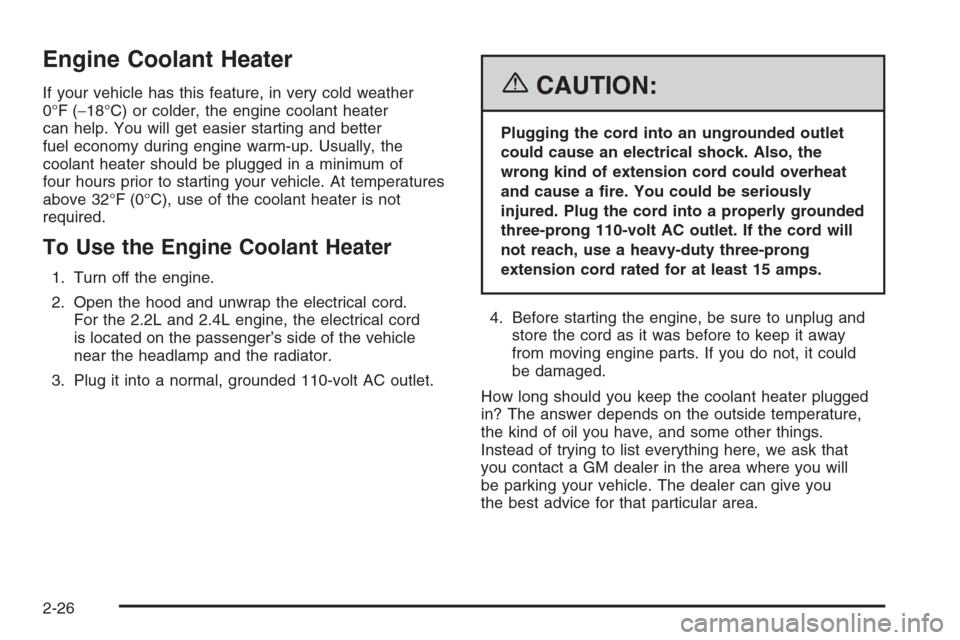
Engine Coolant Heater
If your vehicle has this feature, in very cold weather
0°F (−18°C) or colder, the engine coolant heater
can help. You will get easier starting and better
fuel economy during engine warm-up. Usually, the
coolant heater should be plugged in a minimum of
four hours prior to starting your vehicle. At temperatures
above 32°F (0°C), use of the coolant heater is not
required.
To Use the Engine Coolant Heater
1. Turn off the engine.
2. Open the hood and unwrap the electrical cord.
For the 2.2L and 2.4L engine, the electrical cord
is located on the passenger’s side of the vehicle
near the headlamp and the radiator.
3. Plug it into a normal, grounded 110-volt AC outlet.
{CAUTION:
Plugging the cord into an ungrounded outlet
could cause an electrical shock. Also, the
wrong kind of extension cord could overheat
and cause a �re. You could be seriously
injured. Plug the cord into a properly grounded
three-prong 110-volt AC outlet. If the cord will
not reach, use a heavy-duty three-prong
extension cord rated for at least 15 amps.
4. Before starting the engine, be sure to unplug and
store the cord as it was before to keep it away
from moving engine parts. If you do not, it could
be damaged.
How long should you keep the coolant heater plugged
in? The answer depends on the outside temperature,
the kind of oil you have, and some other things.
Instead of trying to list everything here, we ask that
you contact a GM dealer in the area where you will
be parking your vehicle. The dealer can give you
the best advice for that particular area.
2-26
Page 242 of 394
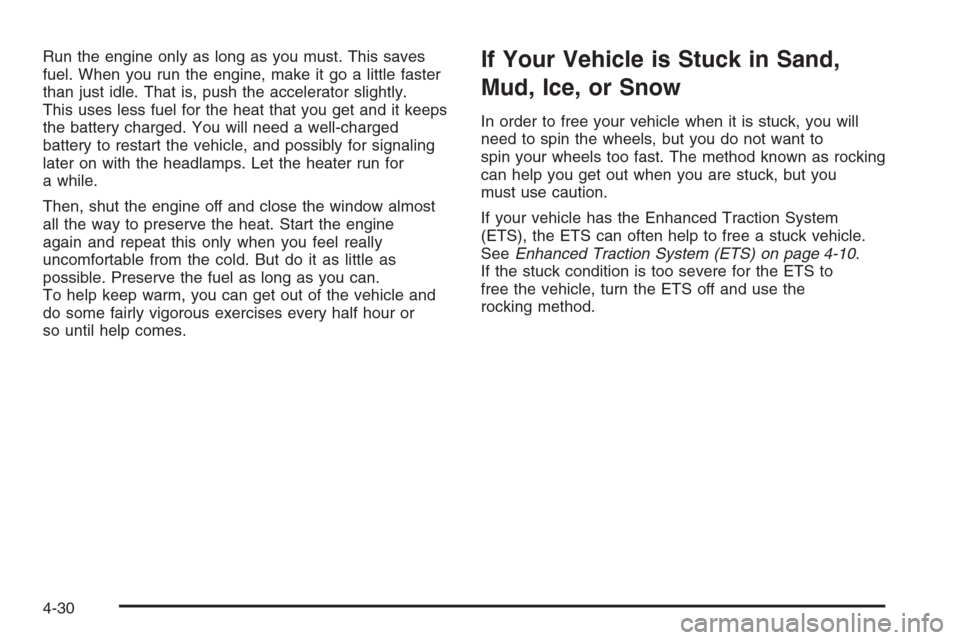
Run the engine only as long as you must. This saves
fuel. When you run the engine, make it go a little faster
than just idle. That is, push the accelerator slightly.
This uses less fuel for the heat that you get and it keeps
the battery charged. You will need a well-charged
battery to restart the vehicle, and possibly for signaling
later on with the headlamps. Let the heater run for
a while.
Then, shut the engine off and close the window almost
all the way to preserve the heat. Start the engine
again and repeat this only when you feel really
uncomfortable from the cold. But do it as little as
possible. Preserve the fuel as long as you can.
To help keep warm, you can get out of the vehicle and
do some fairly vigorous exercises every half hour or
so until help comes.If Your Vehicle is Stuck in Sand,
Mud, Ice, or Snow
In order to free your vehicle when it is stuck, you will
need to spin the wheels, but you do not want to
spin your wheels too fast. The method known as rocking
can help you get out when you are stuck, but you
must use caution.
If your vehicle has the Enhanced Traction System
(ETS), the ETS can often help to free a stuck vehicle.
SeeEnhanced Traction System (ETS) on page 4-10.
If the stuck condition is too severe for the ETS to
free the vehicle, turn the ETS off and use the
rocking method.
4-30
Page 280 of 394
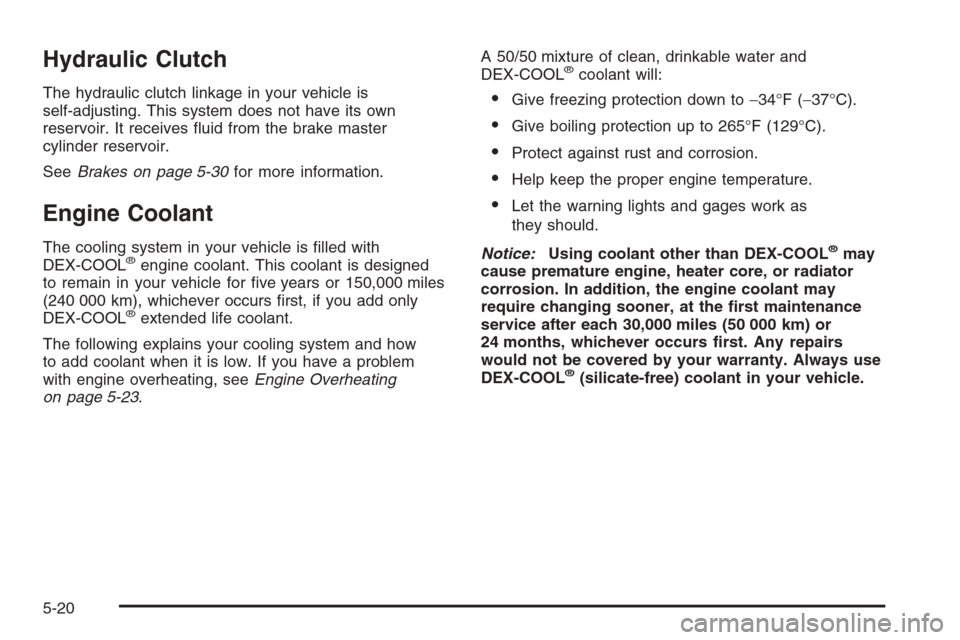
Hydraulic Clutch
The hydraulic clutch linkage in your vehicle is
self-adjusting. This system does not have its own
reservoir. It receives �uid from the brake master
cylinder reservoir.
SeeBrakes on page 5-30for more information.
Engine Coolant
The cooling system in your vehicle is �lled with
DEX-COOL®engine coolant. This coolant is designed
to remain in your vehicle for �ve years or 150,000 miles
(240 000 km), whichever occurs �rst, if you add only
DEX-COOL
®extended life coolant.
The following explains your cooling system and how
to add coolant when it is low. If you have a problem
with engine overheating, seeEngine Overheating
on page 5-23.A 50/50 mixture of clean, drinkable water and
DEX-COOL
®coolant will:
Give freezing protection down to−34°F (−37°C).
Give boiling protection up to 265°F (129°C).
Protect against rust and corrosion.
Help keep the proper engine temperature.
Let the warning lights and gages work as
they should.
Notice:Using coolant other than DEX-COOL
®may
cause premature engine, heater core, or radiator
corrosion. In addition, the engine coolant may
require changing sooner, at the �rst maintenance
service after each 30,000 miles (50 000 km) or
24 months, whichever occurs �rst. Any repairs
would not be covered by your warranty. Always use
DEX-COOL
®(silicate-free) coolant in your vehicle.
5-20
Page 281 of 394
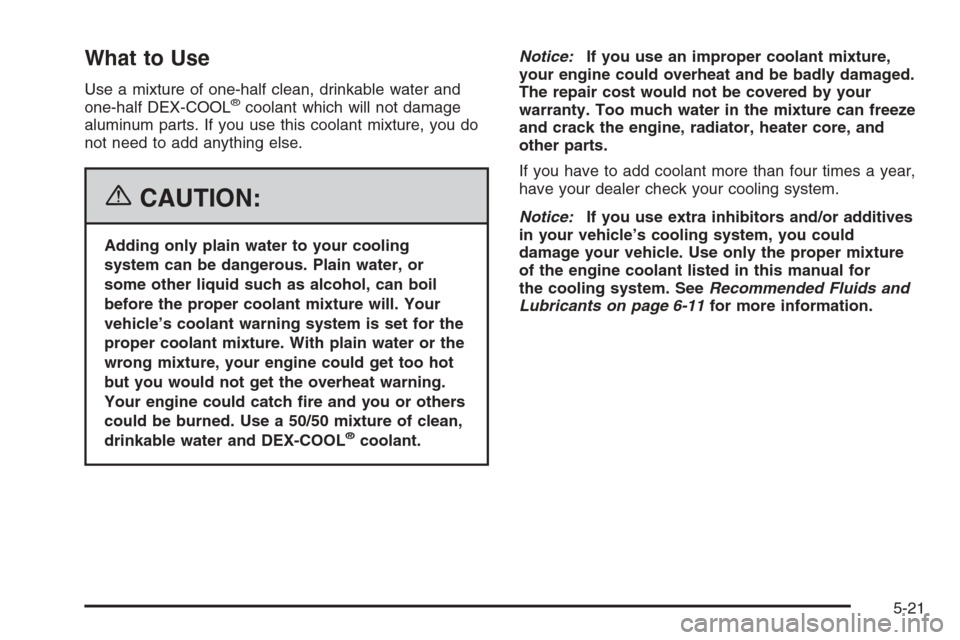
What to Use
Use a mixture of one-half clean, drinkable water and
one-half DEX-COOL®coolant which will not damage
aluminum parts. If you use this coolant mixture, you do
not need to add anything else.
{CAUTION:
Adding only plain water to your cooling
system can be dangerous. Plain water, or
some other liquid such as alcohol, can boil
before the proper coolant mixture will. Your
vehicle’s coolant warning system is set for the
proper coolant mixture. With plain water or the
wrong mixture, your engine could get too hot
but you would not get the overheat warning.
Your engine could catch �re and you or others
could be burned. Use a 50/50 mixture of clean,
drinkable water and DEX-COOL
®coolant.Notice:If you use an improper coolant mixture,
your engine could overheat and be badly damaged.
The repair cost would not be covered by your
warranty. Too much water in the mixture can freeze
and crack the engine, radiator, heater core, and
other parts.
If you have to add coolant more than four times a year,
have your dealer check your cooling system.
Notice:If you use extra inhibitors and/or additives
in your vehicle’s cooling system, you could
damage your vehicle. Use only the proper mixture
of the engine coolant listed in this manual for
the cooling system. SeeRecommended Fluids and
Lubricants on page 6-11for more information.
5-21
Page 284 of 394
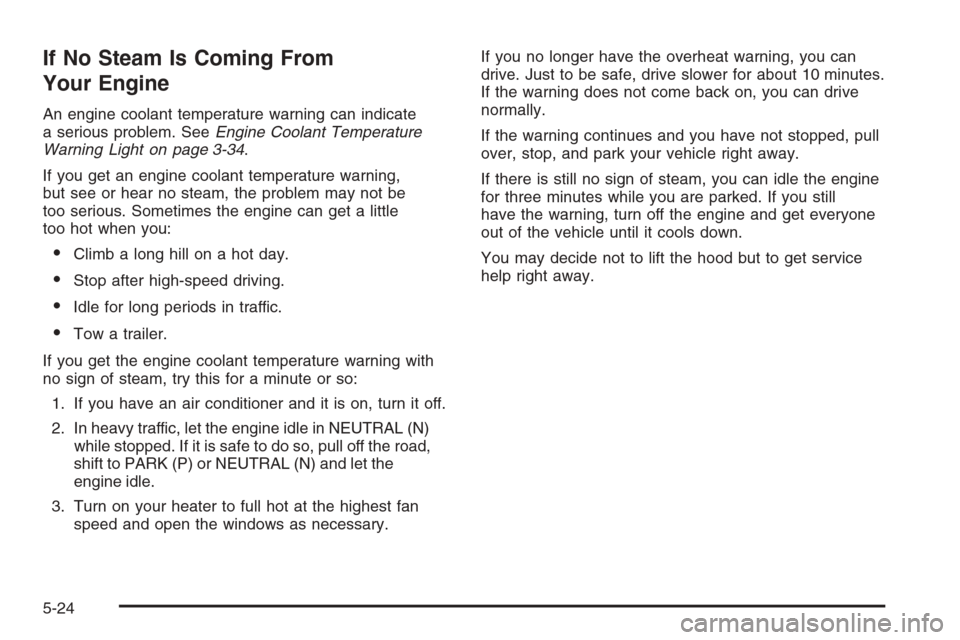
If No Steam Is Coming From
Your Engine
An engine coolant temperature warning can indicate
a serious problem. SeeEngine Coolant Temperature
Warning Light on page 3-34.
If you get an engine coolant temperature warning,
but see or hear no steam, the problem may not be
too serious. Sometimes the engine can get a little
too hot when you:
Climb a long hill on a hot day.
Stop after high-speed driving.
Idle for long periods in traffic.
Tow a trailer.
If you get the engine coolant temperature warning with
no sign of steam, try this for a minute or so:
1. If you have an air conditioner and it is on, turn it off.
2. In heavy traffic, let the engine idle in NEUTRAL (N)
while stopped. If it is safe to do so, pull off the road,
shift to PARK (P) or NEUTRAL (N) and let the
engine idle.
3. Turn on your heater to full hot at the highest fan
speed and open the windows as necessary.If you no longer have the overheat warning, you can
drive. Just to be safe, drive slower for about 10 minutes.
If the warning does not come back on, you can drive
normally.
If the warning continues and you have not stopped, pull
over, stop, and park your vehicle right away.
If there is still no sign of steam, you can idle the engine
for three minutes while you are parked. If you still
have the warning, turn off the engine and get everyone
out of the vehicle until it cools down.
You may decide not to lift the hood but to get service
help right away.
5-24
Page 286 of 394
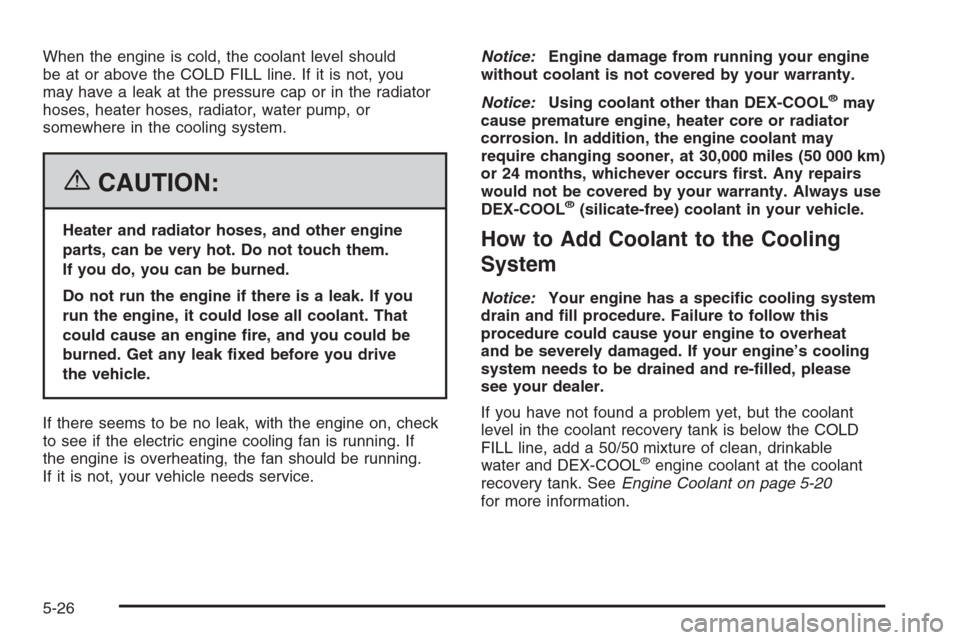
When the engine is cold, the coolant level should
be at or above the COLD FILL line. If it is not, you
may have a leak at the pressure cap or in the radiator
hoses, heater hoses, radiator, water pump, or
somewhere in the cooling system.
{CAUTION:
Heater and radiator hoses, and other engine
parts, can be very hot. Do not touch them.
If you do, you can be burned.
Do not run the engine if there is a leak. If you
run the engine, it could lose all coolant. That
could cause an engine �re, and you could be
burned. Get any leak �xed before you drive
the vehicle.
If there seems to be no leak, with the engine on, check
to see if the electric engine cooling fan is running. If
the engine is overheating, the fan should be running.
If it is not, your vehicle needs service.Notice:Engine damage from running your engine
without coolant is not covered by your warranty.
Notice:Using coolant other than DEX-COOL
®may
cause premature engine, heater core or radiator
corrosion. In addition, the engine coolant may
require changing sooner, at 30,000 miles (50 000 km)
or 24 months, whichever occurs �rst. Any repairs
would not be covered by your warranty. Always use
DEX-COOL
®(silicate-free) coolant in your vehicle.
How to Add Coolant to the Cooling
System
Notice:Your engine has a speci�c cooling system
drain and �ll procedure. Failure to follow this
procedure could cause your engine to overheat
and be severely damaged. If your engine’s cooling
system needs to be drained and re-�lled, please
see your dealer.
If you have not found a problem yet, but the coolant
level in the coolant recovery tank is below the COLD
FILL line, add a 50/50 mixture of clean, drinkable
water and DEX-COOL
®engine coolant at the coolant
recovery tank. SeeEngine Coolant on page 5-20
for more information.
5-26
Page 287 of 394
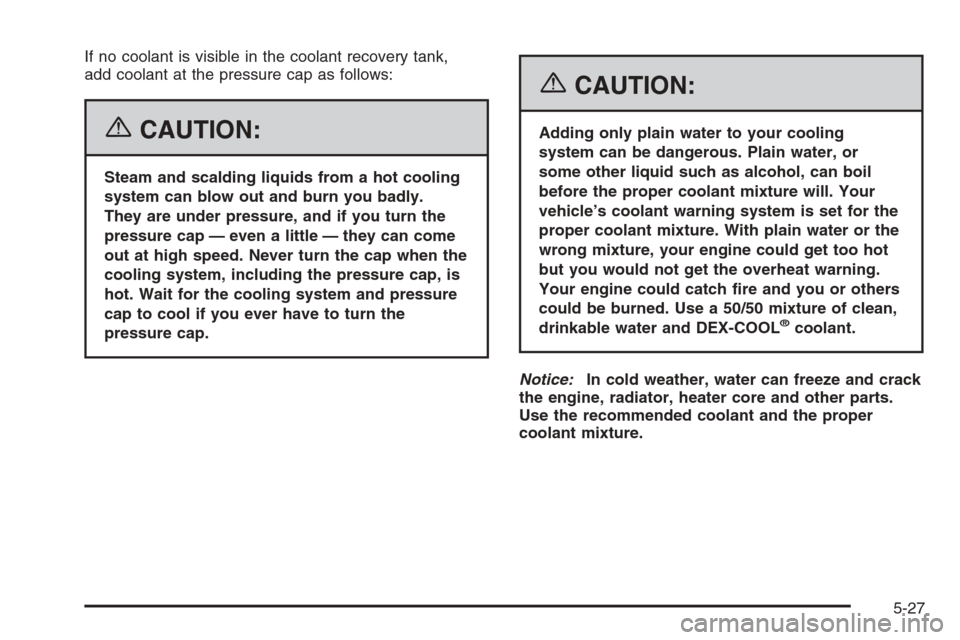
If no coolant is visible in the coolant recovery tank,
add coolant at the pressure cap as follows:
{CAUTION:
Steam and scalding liquids from a hot cooling
system can blow out and burn you badly.
They are under pressure, and if you turn the
pressure cap — even a little — they can come
out at high speed. Never turn the cap when the
cooling system, including the pressure cap, is
hot. Wait for the cooling system and pressure
cap to cool if you ever have to turn the
pressure cap.
{CAUTION:
Adding only plain water to your cooling
system can be dangerous. Plain water, or
some other liquid such as alcohol, can boil
before the proper coolant mixture will. Your
vehicle’s coolant warning system is set for the
proper coolant mixture. With plain water or the
wrong mixture, your engine could get too hot
but you would not get the overheat warning.
Your engine could catch �re and you or others
could be burned. Use a 50/50 mixture of clean,
drinkable water and DEX-COOL
®coolant.
Notice:In cold weather, water can freeze and crack
the engine, radiator, heater core and other parts.
Use the recommended coolant and the proper
coolant mixture.
5-27
Page 383 of 394
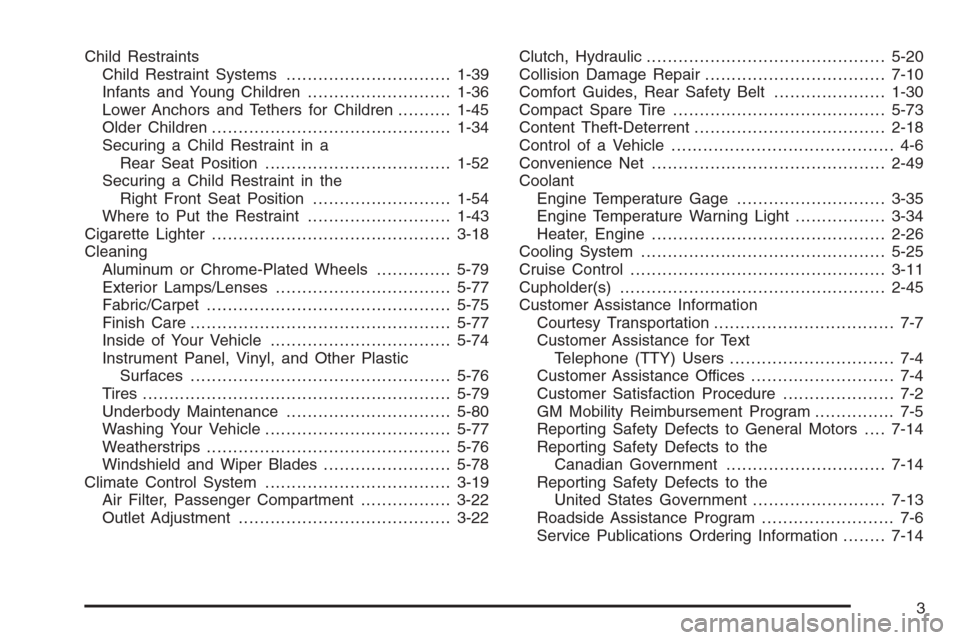
Child Restraints
Child Restraint Systems...............................1-39
Infants and Young Children...........................1-36
Lower Anchors and Tethers for Children..........1-45
Older Children.............................................1-34
Securing a Child Restraint in a
Rear Seat Position...................................1-52
Securing a Child Restraint in the
Right Front Seat Position..........................1-54
Where to Put the Restraint...........................1-43
Cigarette Lighter.............................................3-18
Cleaning
Aluminum or Chrome-Plated Wheels..............5-79
Exterior Lamps/Lenses.................................5-77
Fabric/Carpet..............................................5-75
Finish Care.................................................5-77
Inside of Your Vehicle..................................5-74
Instrument Panel, Vinyl, and Other Plastic
Surfaces.................................................5-76
Tires..........................................................5-79
Underbody Maintenance...............................5-80
Washing Your Vehicle...................................5-77
Weatherstrips..............................................5-76
Windshield and Wiper Blades........................5-78
Climate Control System...................................3-19
Air Filter, Passenger Compartment.................3-22
Outlet Adjustment........................................3-22Clutch, Hydraulic.............................................5-20
Collision Damage Repair..................................7-10
Comfort Guides, Rear Safety Belt.....................1-30
Compact Spare Tire........................................5-73
Content Theft-Deterrent....................................2-18
Control of a Vehicle.......................................... 4-6
Convenience Net............................................2-49
Coolant
Engine Temperature Gage............................3-35
Engine Temperature Warning Light.................3-34
Heater, Engine............................................2-26
Cooling System..............................................5-25
Cruise Control................................................3-11
Cupholder(s)..................................................2-45
Customer Assistance Information
Courtesy Transportation.................................. 7-7
Customer Assistance for Text
Telephone (TTY) Users............................... 7-4
Customer Assistance Offices........................... 7-4
Customer Satisfaction Procedure..................... 7-2
GM Mobility Reimbursement Program............... 7-5
Reporting Safety Defects to General Motors....7-14
Reporting Safety Defects to the
Canadian Government..............................7-14
Reporting Safety Defects to the
United States Government.........................7-13
Roadside Assistance Program......................... 7-6
Service Publications Ordering Information........7-14
3
Page 384 of 394
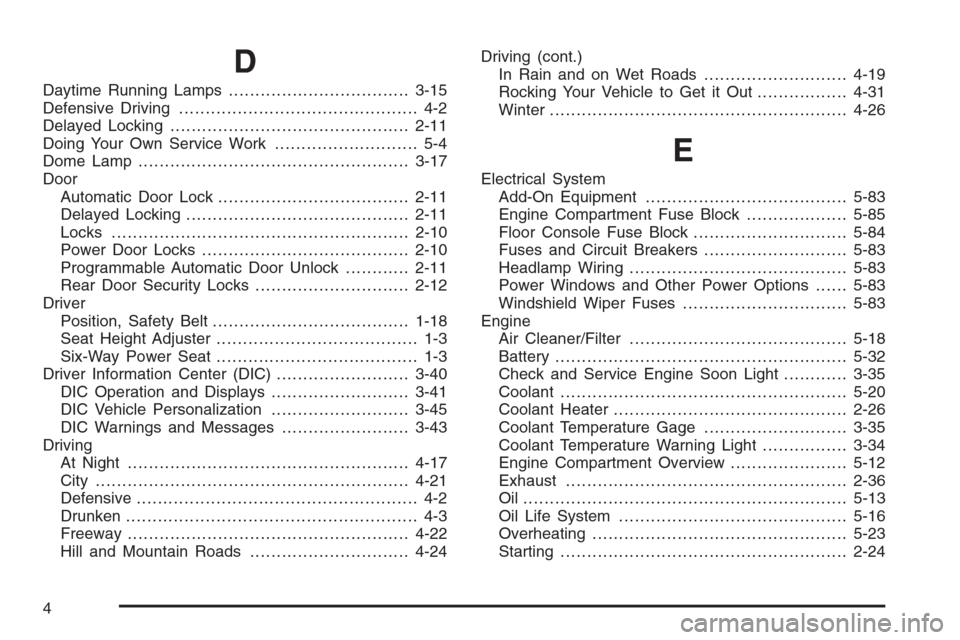
D
Daytime Running Lamps..................................3-15
Defensive Driving............................................. 4-2
Delayed Locking.............................................2-11
Doing Your Own Service Work........................... 5-4
Dome Lamp ...................................................3-17
Door
Automatic Door Lock....................................2-11
Delayed Locking..........................................2-11
Locks........................................................2-10
Power Door Locks.......................................2-10
Programmable Automatic Door Unlock............2-11
Rear Door Security Locks.............................2-12
Driver
Position, Safety Belt.....................................1-18
Seat Height Adjuster...................................... 1-3
Six-Way Power Seat...................................... 1-3
Driver Information Center (DIC).........................3-40
DIC Operation and Displays..........................3-41
DIC Vehicle Personalization..........................3-45
DIC Warnings and Messages........................3-43
Driving
At Night.....................................................4-17
City ...........................................................4-21
Defensive..................................................... 4-2
Drunken....................................................... 4-3
Freeway.....................................................4-22
Hill and Mountain Roads..............................4-24Driving (cont.)
In Rain and on Wet Roads...........................4-19
Rocking Your Vehicle to Get it Out.................4-31
Winter........................................................4-26
E
Electrical System
Add-On Equipment......................................5-83
Engine Compartment Fuse Block...................5-85
Floor Console Fuse Block.............................5-84
Fuses and Circuit Breakers...........................5-83
Headlamp Wiring.........................................5-83
Power Windows and Other Power Options......5-83
Windshield Wiper Fuses...............................5-83
Engine
Air Cleaner/Filter.........................................5-18
Battery.......................................................5-32
Check and Service Engine Soon Light............3-35
Coolant......................................................5-20
Coolant Heater............................................2-26
Coolant Temperature Gage...........................3-35
Coolant Temperature Warning Light................3-34
Engine Compartment Overview......................5-12
Exhaust.....................................................2-36
Oil .............................................................5-13
Oil Life System...........................................5-16
Overheating................................................5-23
Starting......................................................2-24
4